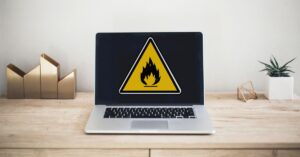If your laptop is starting to slow down, you’re not the only one facing this issue, as it’s a common scenario. Laptops tend to slow down over time, for a variety of reasons. While some can’t be fixed, there are many reasons why a laptop runs slower than usual, which are easy to work around and fixed quickly.
In this article, we will list the most common causes of laptop slowdowns and ways to fix these problems. If your laptop runs slow, this article will likely help you get rid of the problem, and get your laptop back to the same old smoothness it once was.
Why Is Your Laptop Slow?
While it is a rather long list when it comes to the reasons behind a laptop running slow, we have curated a list of the most common reasons and their fixes, which are usually the culprits behind the issue. Some of these are software-related reasons, while some are related to your laptop’s hardware as well.
How To Fix Slow Laptop?
Restart Your Laptop
If your laptop is running slowly, the first thing you should do is restart it. This will temporarily free data from RAM (random access memory) and stop processes running in the background. This is especially important if you frequently let your laptop turn up, sleep, or hibernate.
It’s also important to note that Windows has a Fast Startup feature, which shuts down your laptop and puts it into a state of hibernation. So, instead of turning off your laptop completely, make sure to restart it from time to time.
Fix: To restart your Windows laptop, press the “Windows + X” keys on your laptop keyboard and hover your mouse to Shut down or sign out. And then, select Restart from the pop-up list.
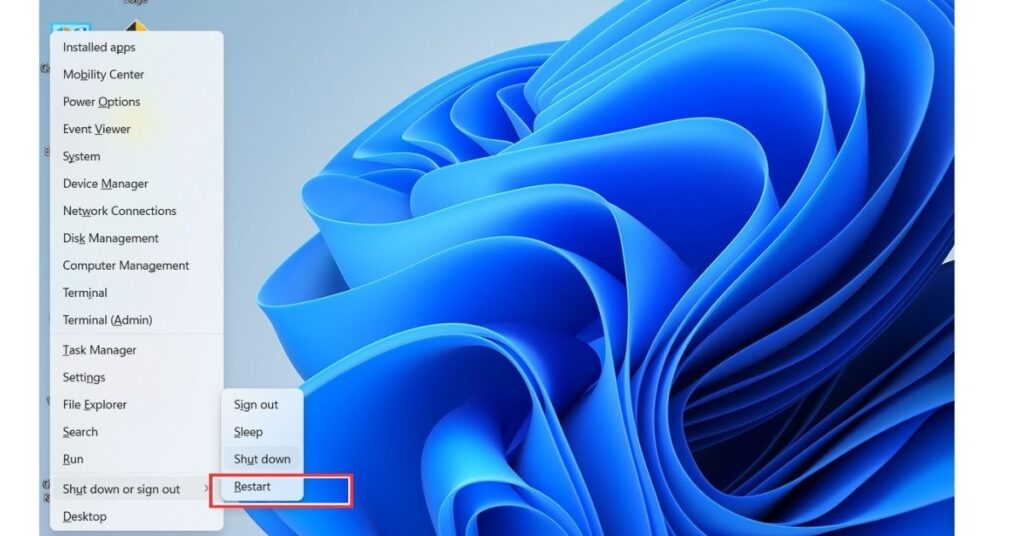
Then select Restart. To ensure that your laptop restarts completely, press the “Windows + X” keys and select “Task Manager” from the pop-up window. Then select the “Performance” tab and select “CPU.” After, check under Up Time and make sure the time is close to zero.
Also Read: Is It Okay To Use a Laptop While Charging? Why Or Why Not?
Close Browser Tabs
If restarting your browser still doesn’t help resolve the issue, it’s possible that you need to close a tab.
Anyone used to running their browser with ten or more tabs open might feel a bit slow. Since all those tabs require RAM, your laptop will allocate more resources each time you open a new tab.
If you’re staring at your browser and the entire top of your screen is full, it’s probably time to spend 5 minutes opening an unnecessary tab.
Check any other windows running outside of your main browser window as well, as these may have too many tabs that slow your laptop.
Quit Intensive Programs
If your laptop is slow, you can try closing programs that are using your CPU and memory. However, some programs will continue to run in the background even after you close them. These settings can use up your processing power, which can slow down your laptop.
Fix: To see which programs are slowing down your laptop, press the “Windows + X” keys on your keyboard and select “Task Manager.” Then go to the “Processes” tab and click on each column title to see which programs use the most resources. Then, select a program and click End Task to force quit it.

However, there may be some programs running in the background that are required to keep your laptop running smoothly. So, make sure you know what a program does before you force it to run.
Disable Startup Programs
If you have too many programs open when you start your computer, your laptop may slow down. Startup Programs will automatically turn on every time you turn on the laptop and work until you turn it off, slowing everything down in the process.
Fix: To see which programs open when you start your laptop, press the “Windows + X” keys on your keyboard and select “Task Manager.” Then click on the Startup tab (or Startup Apps on Windows 11). Lastly, select a program right-click, and then click “Disable.”

Click on the Startup Impact column header to see which applications are slowing down your laptop the most.
Also Read: Laptop Keyboard Not Working? Here’s How To Fix It In No Time
Turn Off Power Saver Mode
To help your battery last longer, there’s a chance you’ve enabled Power Saver mode in the past. If so, you can speed up your Windows laptop faster by switching to Balanced or High-Performance modes.
Fix: To disable Power Saver mode on a Windows 10 laptop, right-click on the battery icon in the bottom-right corner of your screen and select “Power options.” Then click “Create a Power Plan” on the left and select “Balanced” or “High Performance.” Finally, select Next > Create.
If you are running Windows 11 on your laptop, you can find all these options by pressing the “Windows + I” keys on your keyboard and going to System > Power & battery. Then select the menu next to “Power mode” and select “Balanced” or “Best Performance.”

Free Up Space on Your Hard Drive
Your hard drive is your laptop’s long-term memory, and it will still cause problems when it is filled to capacity. You may not be able to install new applications, and you may find yourself stuck all over the place. This happens because many apps, and even Windows itself, need space to store temporary files.
Fix: You can check your laptop’s storage by opening “Windows Settings” and selecting “System,” then “Storage.” Windows will display a bar graph showing how much storage is being used. If your hard drive is too full, the bar turns red.

It also gives you a list of how your storage is used. (if you select the “Show more categories” Option in window 11) This includes apps, temporary files, videos, music, OneDrive files, and more. You can choose any of them to not only see partitions of the space it’s taking up but also to uninstall apps or start emptying temporary storage. Apps and their features almost always take up a lot of space, so exploring that section and uninstalling large apps is the most efficient way to free up space.
Update Your Operating System
If you haven’t updated the operating system on your laptop for a while, you may miss new driver updates and software patches. This slows down your laptop and makes it more vulnerable to security problems, which can be used by hackers to compromise your computer.
Fix: Press the “Windows + I” keys on your keyboard to open the settings and see if you need to update your OS. Then select “Update & Security” (or “Windows Update” on Windows 11) and click on “Check for updates.” Finally, if there is additional information, click “Download.”
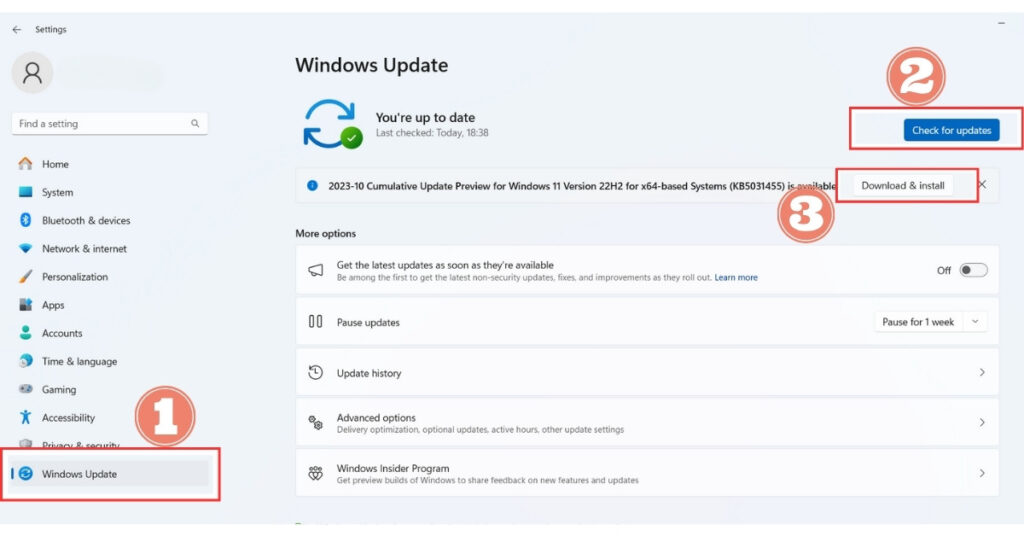
You will then need to restart your laptop for the changes to take effect.
Also Read: Want to Enable On-Screen Keyboard Display? Here Are 6 Ways
Limit Your Multi-Tasking
Sometimes we just ask our computers for too much. They have limited processing power, after all, and most laptops (especially older ones) will struggle to do gaming at the same time as music apps. This can be mitigated somewhat by lowering the graphic setting, but generally, it’s best to lower your expectations.
Pause OneDrive Syncing
Most Windows laptops come with the program OneDrive pre-installed. This feature allows you to store important files in the cloud, so you can access them from another computer. However, OneDrive can significantly slow down your laptop whenever it syncs files.
Fix: To pause OneDrive, tap the “cloud icon” in the bottom right corner of your screen. Then click on the “gear icon” in the top right corner of the pop-up window and select “Pause syncing.” Finally, choose how long you want OneDrive to be down, from 2 hours to 24 hours.

If you don’t see this icon in your taskbar, use the search bar by clicking on the Windows icon at the bottom of your screen or by navigating to your list of apps.
If you find that OneDrive is slowing down your laptop, you can always unlink it from your computer. To do this, click the “OneDrive icon” on your taskbar and then click the “gear icon.” Then, select Settings > Accounts > Unlink this PC.
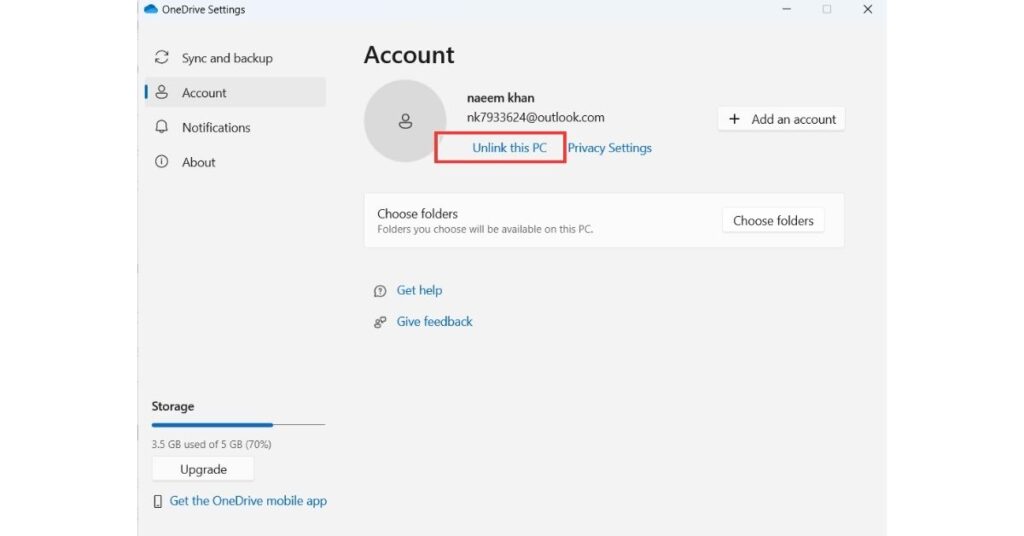
Upgrade Your Hard Drive
If you’re still using a traditional hard disk drive, you may want to move up to a new SSD. The HDD uses a physical disk to store data, while an SSD has no moving parts. Because of this, an SSD can read and write data many times faster than an HDD.
Fix: Many laptops these days offer empty M.2 slots so it’s easy to install an SSD. All you need to install these small hard drives is a screwdriver. And, if your laptop has a free M.2 slot, you can also connect your old HDD and use it as a backup drive.
But if your laptop doesn’t come with an empty M.2 slot, it can be hard to figure out how to replace your hard drive. Check your user manual for online tips or instructions to find out how to replace the hard drive in your laptop.
Scan For Malware And Virus
Laptops can be prone to malware and viruses, affecting their performance negatively. If your laptop is attacked with viruses or malware, it may start to slow down. Make sure your antivirus program is running and up to date. If you are experiencing a slow laptop, run an antivirus scan to see if the problem gets fixed.
Additionally, supposedly to your surprise, there are chances that your antivirus is causing slow laptop problems, such as faulty antivirus installation, installing more than one antivirus software, and incompatible issues, many problems like this can cause problems so if your laptop is running slowly Update your antivirus, and if you are going to do a new installation, make sure it is a clean installation.
Defrag Your Laptop
Every time you create, delete, or edit a file on your computer, some of that data gets fragmented. That means file fragments are stored on different parts of your hard drive. Over time, this can slow down your laptop because your drive has to jump around to see any data.
You can partition your computer to collect and organize the data on your drives. And while Windows 10 automatically splits files once a week, you can still do this manually whenever you want. But if your laptop has a solid-state drive (SSD), you don’t need to defrag the drive.
Fix: To defrag a drive, click on the “magnifying glass icon” in the lower-left corner of your screen. Then type “Defrag” in the search box and Open it. After that, In the pop-up window, select your main drive, click “Analyze,” and then select “Optimize.”
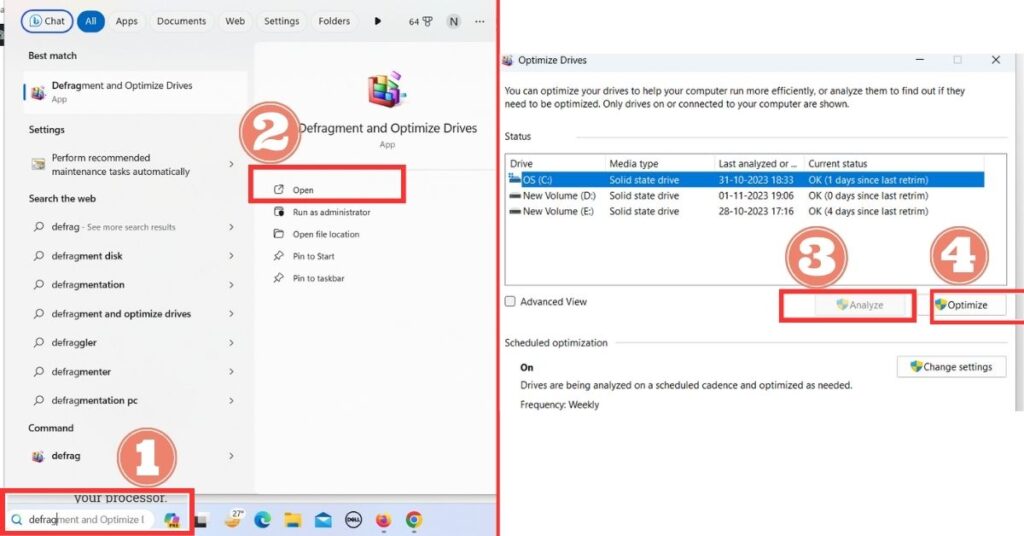
Tip: It is important to wait for the drive to reach 0% fragmented before you start using programs or opening files again.
However, you should only defrag your drive if it is labeled as a “Hard disk drive” (HDD) under Media type. If you see that your drive is labeled as a “Solid-state drive,” defragging it can actually wear down your drive and slow your computer down.
Also Read: Is Your Laptop Touchpad Not Working? Here Are 10 Fixes
Add More RAM
RAM is temporary storage for your laptop. It stores all the data your PC/laptop needs on standby. Then, when the time comes, it can quickly download the information and send it to your processor.
You can get away with 2-4 GB of RAM for basic tasks like word processing and web browsing. But for multitasking or graphics-intensive programs, you may need 8-16 GB of RAM or more.
While adding more RAM won’t always make your laptop faster, some systems require more than the minimum amount of RAM for maximum performance.
Fix: Press the “Ctrl + Shift + Ese” keys to check how much RAM you have. After that, select the “Performance” tab at the top of your screen. Finally, click “Memory” in the left pane, and you will see the amount of memory in the upper right corner of the window.
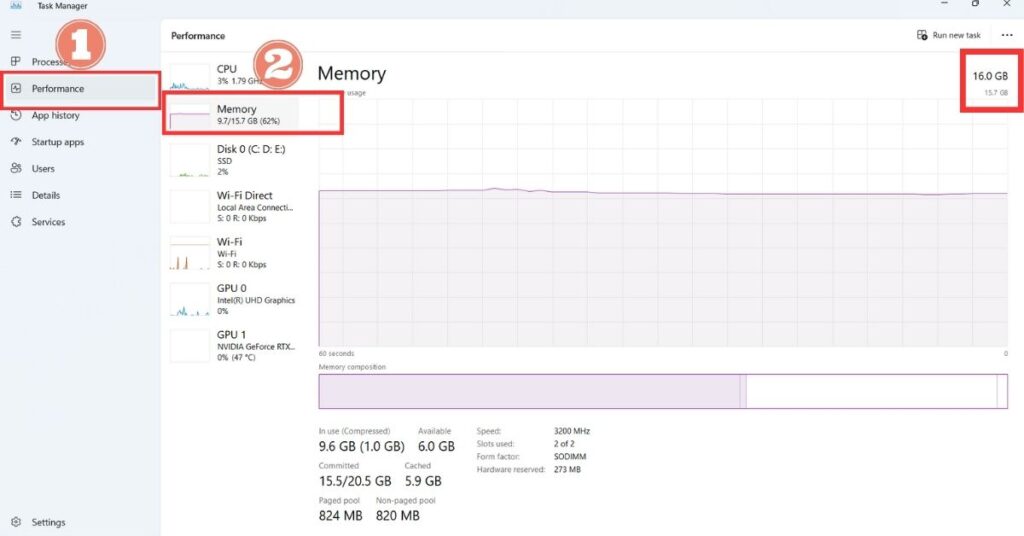
Tip: Under the window under “In Use” you can also see exactly how much RAM you are currently using, and under “Available” as the amount of RAM you are not using.
If you want to increase your RAM, you first need to make sure that your laptop can change your RAM cards. On some laptops, the RAM cards are soldered to the motherboard, preventing you from swapping them out.
In addition, check your RAM specification on your laptop manufacturer’s website. Know how much RAM can be installed and how many RAM slots you can use. Also, make sure you have installed the correct RAM cards; otherwise, they will not work.
Also Read: Best 20 Laptop Shortcut Keys That You Are Not Using
Close System Tray Programs
Some applications don’t close when you press the “X” in the upper right corner. Instead, they minimize the system tray but run in the background (and use your laptop’s resources).
Fix: Fortunately, it’s fairly easy to force these apps to close. To access these options, click the “up arrow” on the right side of your taskbar. If there are programs that no longer need to be run, right-click them and click Close, Quit, or Exit.
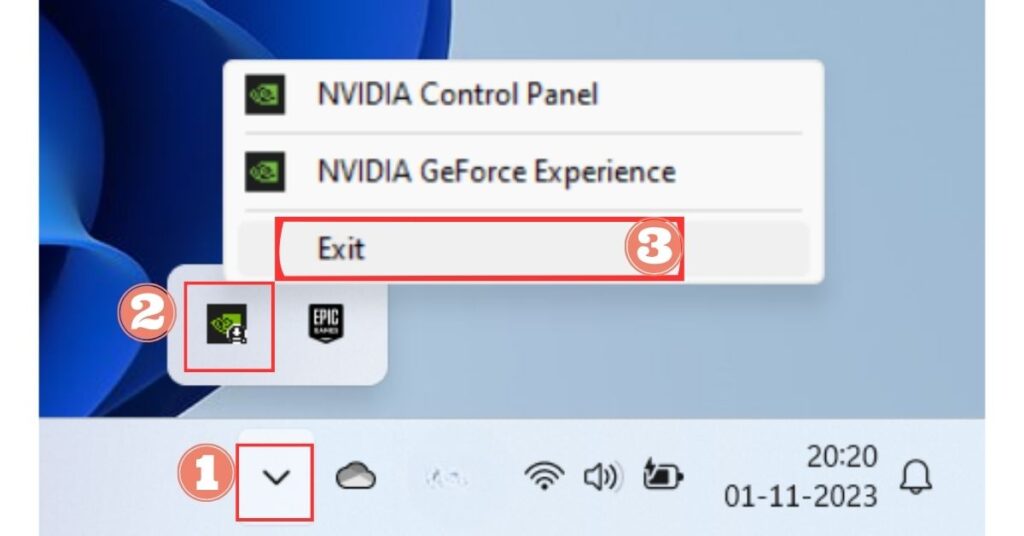
Use Laptop In a Cooler Environment
It is known that a laptop starts slowing down whenever it overheats. This, for that matter, is a common issue with thermal throttling, not just laptops. If you live somewhere very hot, try to use your laptop in a well-ventilated area, or at least give it enough rest to cool down.
Fix: If there is no external source causing the overheating/throttling, it is possible that dust can accumulate in the laptop’s vents, CPU cooler, and internal components To prevent this problem, you would need to clean your laptop by simply removing the back panel and use a brush to remove the dust. Our guide to clean laptops provides the details.
Use Lightweight Software
Some software looks like big, fancy programs like that heavy book. They use a lot of your laptop power and can slow it down. But there are other software options, like smaller and smaller tools, which are just like a few pieces of paper in your backpack. They don’t make your laptop work as hard, so it goes faster.
Fix: If you want your laptop to run faster, try to use smaller, simpler software when you can. For example, instead of using a big, fancy word processor, you can use a simple text editor. You can use an original instead of complicated images. These small pieces of software won’t slow down your laptop so much and will make it work better. It’s like carrying a light backpack instead of a heavy backpack.
Uninstall Programs You Don’t Use
We often put in big programs and don’t realize how much space it takes. If you think it should, you can easily uninstall any unused programs. Even if you have a program that you use frequently now, if it’s particularly large, it’s probably a good idea to reinstall it whenever you need it.
Fix: To uninstall the program, go to Control Panel > Programs > Uninstall Program (or Programs and Features > Uninstall Program in Older Versions).

Check the list of programs on your laptop and decide which ones you don’t really use. If you’re not sure what a program does, you can search for it on the internet to find out more.
Also Read: How to Rotate Laptop Screen: Simple And Easy Ways
Run a Disk Cleanup
Windows has a built-in tool for cleaning up garbage called disk cleanup that has accumulated over time. To access the disk cleanup tool, press “Windows + R” and type “cleanmgr” then press enter.
Here, select the file you want to display and click “OK.” Then click “Clean up system files” and select any system files you want to remove.
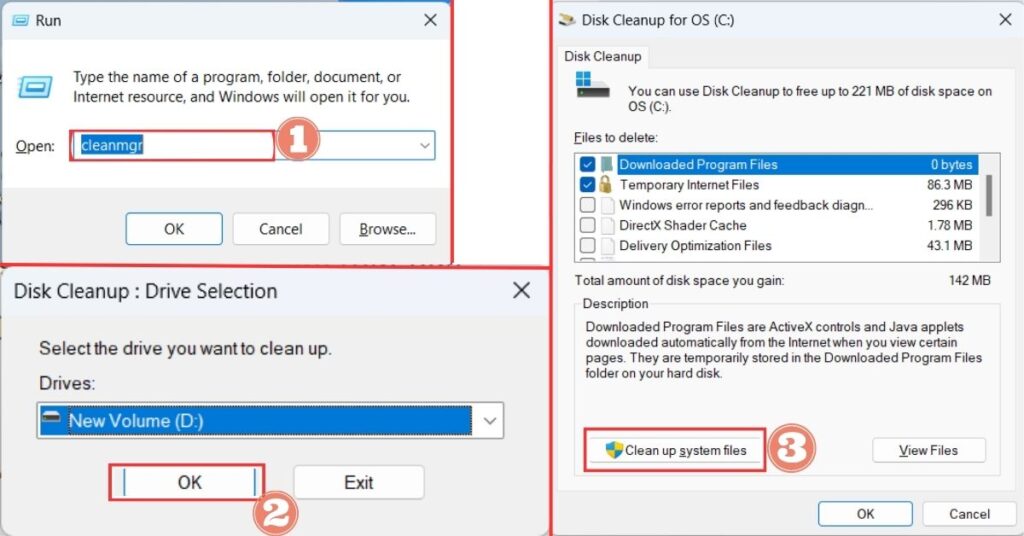
Delete Unnecessary Files
Like our cupboards and drawers, our computers get cluttered. Althought you can’t see it, you know it’s there, and it can negatively impact your computer’s performance. This is especially true if you deal with a lot of large files like high-resolution images, audio files, or videos daily.
Free up space by getting in the habit of deleting files and folders every week, and emptying the recycle bin afterwards. Doing this regularly means you’re much more likely to remember exactly what’s in files and folders and won’t be so concerned about mistakenly deleting something important.
Also Read: Is The Snipping Tool Not Working? HERE ARE 9 Ways To Fix It
Adjust or Disable Graphics and Animations
The most recent version of Windows comes with more graphics, including feeding effects, flyouts, and other animations. These contribute to the beauty and sophistication of the application and contribute to a better overall user experience. On the other hand, they can also slow down your laptop.
Fix: Thankfully it is easy to change this setting and hopefully, you will save some processing power. Press “Windows + R” and type “sysdm.cpl“. then press enter Go to “Advanced.”

The Visual Effects tab is available in “Settings” under the “Performance.”
You can select Adjust for efficiency (this will remove all images) or choose to remove them one by one. It’s optional, but the fade and shadow features are some you can probably live without.



